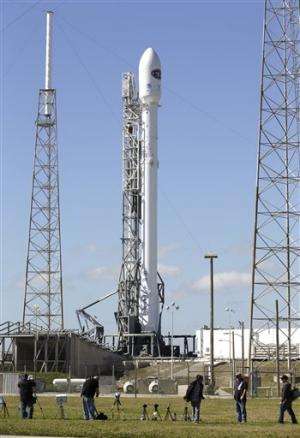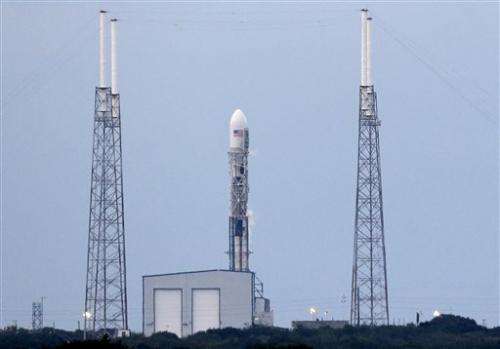SpaceX tries again to launch observatory, nixes landing test

SpaceX counted on better flying weather Wednesday as it geared up for the third time to launch a deep-space observatory, but canceled a radical rocket-landing test because of rough seas.
The unmanned Falcon 9 rocket holds the Deep Space Climate Observatory, a satellite dreamed up by former Vice President Al Gore 17 years ago. Gore planned to return again for the sunset send-off.
High wind nixed Tuesday's try, and radar trouble interfered Sunday. NASA said the wind was calmer for Wednesday's planned 6:03 p.m. launch, with a 90 percent overall chance of favorable conditions.
But waves reaching three stories high crashed over the landing-zone platform floating 370 miles off the Florida coast. Making matters worse, one of four engines needed to keep the platform steady was not working.
And so with three hours or so remaining in the countdown, SpaceX announced it was calling off the landing test of the first-stage booster. It would have been just the second such experiment; last month's try ended in flames when the booster slammed into the platform, fell over and exploded. On Wednesday, the booster, once free a few minutes into flight, still was going to attempt a "soft landing" in the ocean, but was not expected to survive given the harsh conditions.
The countdown was unaffected by the cancellation of the test, a secondary objective for the company led by billionaire Elon Musk.
Launching the observatory on its $340 million mission was the main event. It's the first deep-space mission for SpaceX.
NASA and the National Oceanic and Atmospheric Administration pulled Gore's sacked satellite out of storage nearly a decade ago, and retooled it to monitor solar outbursts while providing continuous pictures of the full, sunlit side of Earth.

The spacecraft will travel 1 million miles, four times farther than the moon, to the so-called Lagrange point, a gravity-neutral position in direct line with the sun. There, it will provide advance warnings of incoming geomagnetic storms that could disrupt power and communications on Earth.
If unlucky again Wednesday, SpaceX would have to wait until Feb. 20 to launch because of interference to the observatory's flight path from the moon's gravity. Another delay, however, would mean the landing test is back on. The California-based company said it has numerous opportunities for touchdown attempts this year.
Musk wants to start retrieving and reusing his rockets to save time and money. His company just signed a lease with the Air Force for an old launch pad that will be converted into a landing pad.
© 2015 The Associated Press. All rights reserved.





















